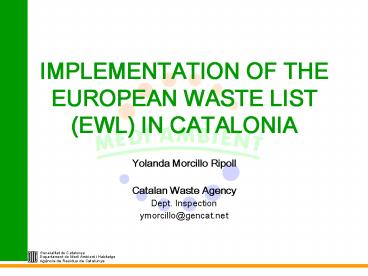IMPLEMENTATION OF THE EUROPEAN WASTE LIST EWL IN CATALONIA - PowerPoint PPT Presentation
1 / 16
Title:
IMPLEMENTATION OF THE EUROPEAN WASTE LIST EWL IN CATALONIA
Description:
Advisory waste treatment pathways associated to each waste code ... T15 Deposici en dip sit de terres i runes. T21 Incineraci de residus no halogenats ... – PowerPoint PPT presentation
Number of Views:45
Avg rating:3.0/5.0
Title: IMPLEMENTATION OF THE EUROPEAN WASTE LIST EWL IN CATALONIA
1
IMPLEMENTATION OF THE EUROPEAN WASTE LIST (EWL)
IN CATALONIA
- Yolanda Morcillo Ripoll
- Catalan Waste Agency
- Dept. Inspection
- ymorcillo_at_gencat.net
2
CATALAN WASTE AGENCY
CATALONIA 6.813.319 inhabitants (2004) 31.930 km2
- CATALAN WASTE AGENCY
- AGÈNCIA DE RESIDUS DE CATALUNYA (ARC)
- Development legislation
- Implementation
- Enforcement/Control
- SPANISH MINISTRY OF ENVIRONMENT
- MINISTERIO DE MEDIO AMBIENTE (MMA)
- Basic legislation
CATALONIA
SPAIN
3
GENERATION OF WASTE IN CATALONIA(Figures 2004)
4
WASTE MANAGEMENT FACILITIES IN CATALONIA
Industrial waste 558 Municipal waste 68 (
254) Construction/demolition waste 54
5
INDUSTRIAL WASTE FACILITIES IN CATALONIA
6
INDUSTRIAL WASTE DESTINATION(6.231.303 t in
2004)
7
IMPLEMENTATION OF EWL IN CATALONIA
- Direct use of codes from EWL (as incorporated in
Spanish legislation Orden MAM 304/2002) - NO specific Catalan Waste Catalogue
- Advisory waste treatment pathways associated to
each waste code () - Waste generator is responsible for identifying
and classifying correctly waste. () - NO Spanish/Catalan Guidelines on how to use EWL
and determine Hazardous properties - EWL is used for waste reporting, monitoring of
waste streams, installation permits (IPPC), waste
transport forms, etc.
8
EUROPEAN WASTE CATALOGUE IN CATALONIA
9
EWL IN CATALONIA WASTE TREATMENT PATHWAYS (1)
- V (Valorització). RECOVERY. Based on Recovery
operations (Annex IIB, Dir 75/442/EEC) - T (Tractament i disposició del rebuig).
DISPOSAL (and treatment prior to disposal).
Based on Disposal operations (Annex II, Dir
75/442/EEC)
T - Tractament i disposició del rebuig
T11 Deposició de residus inerts
T12 Deposició de residus no especials
T13 Deposició de residus especials
T14 Deposició de residus en
monoabocador T15 Deposició en dipòsit
de terres i runes T21 Incineració de
residus no halogenats T22 Incineració
de residus halogenats T23 Incineració
de residus sanitaris T24 Tractament
per evaporació T31 Tractament
fisicoquímic i biològic T32
Tractament específic T33
Estabilització T34 Esterilització
T35 Oxidació humida
10
EWL IN CATALONIAWASTE TREATMENT PATHWAYS (2)
V- Vies de valorització
11
DESCRIPTION OF A WASTE TREATMENT FACILITY.
Example
12
WASTE MANAGEMENT DOCUMENTS
WASTE ACCEPTANCE DOCUMENT -info of
waste -generator -treatment facility -supervise
d by ARC ( required analysis, in case of
landfill disposal)
MIRROR CODES Waste generator manifest
Hazardous/Non Hazardous
13
PROBLEMS EWL IN CATALONIA (1)
- DIFFICULT TO USE (a lot of questions from waste
generators on how to codify/classify waste)(both
due to structure and assessment Hz properties) - DEGREE OF DIFFERENTIATIONIncomplete (e.g.
WEEE)/Redundant (e.g. oils) - MIRROR CODES/HAZARDOUS PROPERTIES-Total
unharmonised way of discerning Hazardous/Non
Hazardous in mirror codes. Different
approaches/different tests (Tests are expensive)
(When and how to test? Which substances to look
for?) - -Very often classification Hz/Non Hz is not
accurately assessed (rough approach). - -In general, hazardous properties that dont
have a clear assessment method (EWL article 2)
are not used (e.g. H12, H13, H14). - UNCLEAR/UNCERTAINTIESSame waste is codified
different by different agents.
14
PROBLEMS (2)
- OTHERS
- Not relevant information in some waste codes
- Some codes may include very different wastes
with different compositions and properties (e.g.
solvents), and in our system they have assigned a
lot of possible treatment pathways (Recovery and
Disposal) - Generators/waste managers stick to some codes (a
lot of other codes are not used). - Often, selection of a waste code is done
according to permitted treatment pathways or
installation permits (IPPC), in order to comply
our legislation. - Generators very often classify waste according to
Catalan landfill admission criteria. - EWL not integrated with other waste
classifications (TFS 259/93, waste statistics)
15
SUGGESTIONS
- REVIEW EWL STRUCTURE
- (Criteria material, origin, )
- REVIEW EWL CONTENT (DEGREE OF DIFFERENTIATION)
- Removal/addition of some codes for real needs
- BETTER DEFINITION OF SOME HAZARDOUS PROPERTIES
- (Specially those not included in Substances
legislation) - Correct some specific contradictions with
substances legislation - EU GUIDELINES
- - Clarify frequent doubtful codes.
- - Examples of wastes that can be found in each
code, and waste information possible Hazardous
substances contents, possible Hazardous
properties, possible treatment pathways. - - Advice on each pair of mirror codes where
enough experience is achieved, to assist and
simplify the procedure to get the right
classification. When and How to test in these
cases. - - General guidelines on adaptation of Substances
legislation to be applied in waste (When? How?
Which method?) - EU TRAINING FOR COMPETENT AUTHORITIES
16
THANK YOU
- Yolanda Morcillo Ripoll
- www.arc-cat.net

